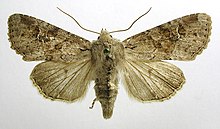Rustic Shoulder-knot
| Rustic shoulder-knot | |
|---|---|
 |
|
 |
|
| mounted | |
| Scientific classification | |
| Kingdom: | Animalia |
| Phylum: | Arthropoda |
| Class: | Insecta |
| Order: | Lepidoptera |
| Family: | Noctuidae |
| Tribe: | Apameini |
| Genus: | Apamea |
| Species: | A. sordens |
| Binomial name | |
|
Apamea sordens (Hufnagel, 1766) |
|
| Synonyms | |
|
|
Apamea sordens, the rustic shoulder-knot or bordered apamea, is a moth of the family Noctuidae. It is distributed throughout Europe, East across the Palearctic to Central Asia and to China and Japan. It also occurs in North America (Labrador to Virginia, west across Canada, south to Minnesota).
This moth has a wingspan of 36 to 42 mm. The forewings are brown with mostly indistinct markings except for the narrow black mark at the base of the wing which gives the species its common name. The hindwings are greyish brown, darker towards the margins, with prominent dark venation. This moth flies at night and is attracted to light and sugar.
Forewing dull lilac grey, flushed with fawn colour, especially in median area; a black, semibifid streak from base below cell; lines brownish, double, indistinct; the median shade dark grey or fawn colour, diffuse and prominent; orbicular stigma pale, black-edged; reniform large with grey centre, blackish in lower lobe, with pale annulus and black outline; claviform small, with dark outline; submarginal line dull, with darker shades in places on each side; hindwing greyish fuscous, paler towards base; — in basistriga Stgr. the ground colour is bluish grey except the median area, and the black basal streak is stronger; this form is recorded from W. Turkestan, E. Siberia, Japan, and China, also from Norway; a small series from Pescocostanzo, Italy seems referable here; — ab. grisescens Stgr. from Tibet and Turkestan is altogether paler and greyer; — ab. unicolor Tutt is a melanistic form from the North of England, in which the ground is dark reddish brown with a purplish tinge, the stigmata and lines more or less obscured; hindwing much darker; — pallida Tutt and cinerascens Tutt are both grey forms without any rufous admixture, the former being pale ochreous grey, and the latter dull ashy grey, the one from Ireland, the other from North England; this latter form probably occurs, however, in other localities, and is distinct from Staudinger's Central Asiatic form grisescens, for which Spuler quotes Finland and Esthland with a ? as localities. .
...
Wikipedia
